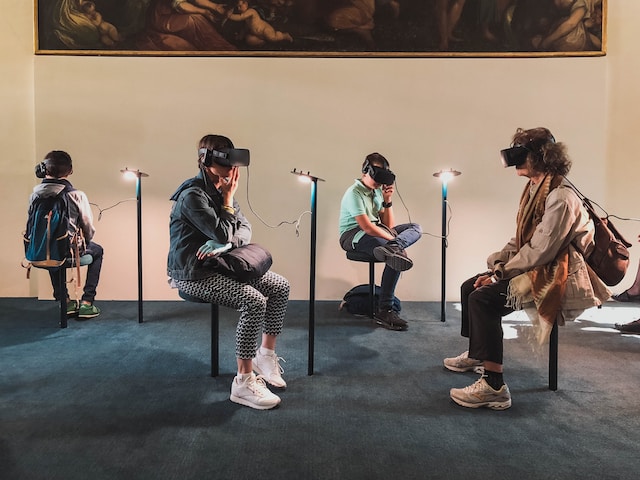Outline:
- Introduction
- Understanding Augmented Reality (AR)
- Applications of AR in Gaming and Entertainment
- Enhancing Retail Experiences with AR
- AR in Healthcare: Revolutionizing Patient Care
- Augmented Reality in Education and Training
- AR for Industrial Applications and Manufacturing
- AR in Architecture and Design
- AR in Marketing and Advertising
- AR in Travel and Tourism
- AR Challenges and Future Development
- The Future of AR: Advancements and Trends
- Ethical Considerations in Augmented Reality
- Conclusion
- FAQs
Unlocking the Potential of Augmented Reality: Transforming Industries and Experiences
Augmented reality (AR) revolutionizes industries by blending physical and digital worlds, creating immersive environments that enhance user experiences. This article explores applications and future prospects of AR in various sectors.
1. Introduction
Augmented reality enhances the perception of reality by overlaying virtual elements, utilizing computer vision, sensor data, and advanced graphics, presenting exciting possibilities for industries and individuals.
2. Understanding Augmented Reality (AR)
Augmented reality integrates digital information and virtual objects into the real world, enhancing perception and enabling interactive, immersive experiences through devices like smartphones and tablets.
3. Applications of AR in Gaming and Entertainment
AR revolutionizes gaming by providing immersive experiences, blurring virtual and real worlds in games like Pokémon Go and Minecraft Earth.
4. Enhancing Retail Experiences with AR
AR is reshaping the retail landscape by providing unique and interactive shopping experiences. Virtual try-on features enable customers to visualize products before making a purchase, reducing the need for physical tryouts. AR-powered interactive catalogs and virtual showrooms provide an engaging and personalized shopping environment.
5. AR in Healthcare: Revolutionizing Patient Care
The healthcare sector has embraced AR to enhance patient care and medical training. Surgeons can use AR overlays during complex procedures for real-time guidance and visualization. AR applications also enable medical professionals to practice simulated surgeries, improving skills and reducing risks.
6. Augmented Reality in Education and Training
AR is transforming education by creating immersive learning experiences. By overlaying virtual objects and information, students can explore complex subjects in a more engaging and interactive manner. AR-based training programs also offer hands-on simulations for various industries, such as aviation, engineering, and manufacturing.
7. AR for Industrial Applications and Manufacturing
AR is revolutionizing industrial processes by improving efficiency, accuracy, and safety. In manufacturing, AR provides real-time visual instructions and guidance to assembly line workers, reducing errors and speeding up production. AR-powered maintenance tools help technicians troubleshoot equipment issues and perform repairs more effectively.
8. AR in Architecture and Design
AR is transforming the architecture and design industry by enabling virtual walkthroughs and visualizations. Architects can overlay 3D models onto real-world environments, allowing clients to experience their designs in a more immersive and realistic way. AR also helps in space planning, interior design, and showcasing design concepts.
9. AR in Marketing and Advertising
AR has created new possibilities in marketing and advertising by providing interactive and engaging experiences for consumers. Brands can use AR to create virtual try-on experiences, interactive product demonstrations, and immersive storytelling campaigns. AR-powered ads capture users’ attention and leave a lasting impression.
10. AR in Travel and Tourism
The travel and tourism industry is leveraging AR to enhance the visitor experience and provide contextual information. AR apps provide interactive guides, historical overlays, and virtual tours of landmarks and attractions. Users can explore destinations in a more immersive and informative way, enhancing their travel experiences.
11. AR Challenges and Future Development
While AR offers immense potential, there are challenges to overcome, including technological limitations, user adoption, and privacy concerns. The development of lightweight, affordable AR devices and advancements in tracking and rendering technologies will drive the future growth of AR applications.
12. The Future of AR: Advancements and Trends
The future of AR is promising, with ongoing advancements in hardware, software, and connectivity. Wearable AR devices like smart glasses are becoming more sophisticated and accessible. Integration with artificial intelligence, machine learning, and 5G technology will unlock new possibilities for AR in areas such as remote collaboration, real-time translations, and contextual information delivery.
13. Ethical Considerations in Augmented Reality
As AR becomes more pervasive, ethical considerations surrounding privacy, data security, and content manipulation come into play. Ensuring transparent data collection and protecting user privacy are essential. Guidelines and regulations will be necessary to address potential ethical issues associated with AR technology.
14. Conclusion
Augmented reality is revolutionizing industries by blending physical and digital worlds, transforming user experiences in gaming, entertainment, healthcare, education, and beyond. As technology evolves, AR’s potential expands, offering exciting possibilities for businesses and individuals.
FAQs – Frequently Asked Questions
Q: What is augmented reality (AR)?
A: Augmented reality enhances perception and interactive experiences by overlaying virtual elements in the real world.
Q: How does AR work?
A: AR works by using devices such as smartphones or smart glasses to overlay digital information onto the real-world environment through computer vision and advanced graphics.
Q: What are some popular applications of AR?
A: Popular applications of AR include gaming and entertainment, retail shopping, healthcare, education and training, industrial applications, architecture and design, marketing and advertising, and travel and tourism.
Q: How does AR enhance the retail experience?
A: AR enhances the retail experience by offering virtual try-on features, interactive catalogs, and virtual showrooms that provide personalized and engaging shopping experiences.
Q: What are the challenges associated with AR?
A: Challenges associated with AR include technological limitations, user adoption, privacy concerns, and ethical considerations surrounding data security and content manipulation.


